
Alpo Dog Food Ingredients
According to our research, Alpo manufactures 20 dog food recipes using 105 unique ingredients. To evaluate the quality of ingredients used by Alpo, we've studied all 105 ingredients. In this article, we'll share our findings on Alpo ingredients.
| Dog Food Recipes | 20 |
| Unique Ingredients | 105 |
| Artificial Colors | 9 |
| Animal By-Products | 2 |
| Anonymous Meats | 5 |
| Controversial | 14 |
| Harmful | 14 |
First 5 Ingredients
Dog food ingredients in the United States are listed in descending order of pre-cooked weight. The first 5 ingredients typically constitute a significant portion of the recipe.
For Alpo, these are the most common ingredients found within the first 5 dog food ingredients.
- water sufficient for processing
- water sufficient for processing
- wheat flour
- wheat gluten
- glycerin
As you can see, the most common first ingredient in Alpo is water sufficient for processing. The most common 2nd ingredient is water sufficient for processing, followed by wheat flour, wheat gluten, and glycerin.
Artificial Food Coloring Dyes
Our records indicate that Alpo does use artificial food coloring dyes. More specifically, we've identified 9 artificial food dyes used by Alpo.
Although these food dyes are classified as Generally Recognized As Safe (GRAS) by the FDA, we recommend avoiding them when possible.
According to the Center For Research In The Public Interest (CSPI), there are many potential health risks associated with the consumption of artificial food coloring dyes.
Given that most pets consume the same products for prolonged periods of time, these concerns should be taken seriously. In general, we recommend pet owners avoid feeding products which contain artificial food coloring dyes.
For more information regarding the CSPI's findings, read our artificial food coloring article.
Red 40 is the most widely used artificial dye in consumer goods. Studies have shown that red 40 may accelerate the appearance of immune-system tumors in mice, cause allergy-like reactions and trigger hyperactivity in children.
The following recipes contain red 40:
Yellow 6 is an artificial food dye which may be contaminated with cancer-causing chemicals. According to the Center For Science In The Public Interest, yellow 6 can cause adrenal tumors in animals.
The following recipes contain yellow 6:
Yellow 6 Lake is a non-soluble form of yellow 6, an artificial dye. According to the Center For Science In The Public Interest, yellow 6 can cause adrenal tumors in animals.
The following recipes contain yellow 6 lake:
Blue 2 is an artificial dye which can increase the likelihood of tumors according to the Center for Science in the Public Interest. Like other dyes, blue 2 does not provide any nutritional value.
The following recipes contain blue 2:
Yellow 5 is an artificial dye which may be contaminated with several cancer-causing chemicals. Like other dyes, yellow 5 does not provide any nutritional value.
The following recipes contain yellow 5:
- Alpo Prime Cuts Savory Beef Flavor
- Alpo Come & Get It Cookout Classics
- Alpo Variety Snaps Little Bites Made With Beef, Chicken, Liver and Lamb Flavors
- Alpo Twist-ables Beef & Cheese Flavors
- Alpo Tbonz Beef & Cheese Flavors
- Alpo Variety Snaps Little Bites Made With Beef, Bacon, Cheese, and Peanut Butter Flavors
The ingredient "added color" is ambiguous and may include various artificial dyes. Most artificial dyes have been linked to various chronic diseases.
The following recipes contain added color:
- Alpo Chop House Rotisserie Chicken Flavor In Gourmet Gravy
- Alpo Chop House Beef Tenderloin Flavor In Gourmet Gravy
- Alpo Chop House T-Bone Steak Flavor In Gourmet Gravy
- Alpo Prime Cuts With Chicken & Wholesome Veggie Accents In Gravy
- Alpo Prime Cuts Stew With Beef & Vegetables In Gravy
- Alpo Prime Cuts With Beef In Gravy
- Alpo Prime Cuts With Lamb & Rice In Gravy
- Alpo Tbonz Filet Mignon Flavor
- Alpo Tbonz Ribeye Flavor
- Alpo Tbonz Porterhouse Flavor
- Alpo Twist-ables Beef & Cheese Flavors
- Alpo Tbonz Chicken Flavor
- Alpo Tbonz Beef & Cheese Flavors
- Alpo Tbonz BBQ Pork Flavor
- Alpo Prime Cuts With Turkey & Wholesome Veggie Accents In Gravy
Red 40 lake is a non-soluble form of red 40, an artificial dye. Studies have shown that red 40 may accelerate the appearance of immune-system tumors in mice, cause allergy-like reactions, and trigger hyperactivity in children.
The following recipes contain red 40 lake:
Yellow 5 Lake is a non-soluble form of yellow 5, an artificial dye. According to the Center For Science In The Public Interest, yellow 5 may be contaminated with several cancer-causing chemicals. Like other dyes, yellow 5 lake does not provide any nutritional value.
The following recipes contain yellow 5 lake:
Blue 1 is an artificial dye with serious but unconfirmed health concerns. Like other dyes, blue 1 does not provide any nutritional value.
The following recipes contain blue 1:
Animal By-Products
Alpo does indeed use animal by-products. More specifically, 2 animal by-product ingredients were found during our analysis of Alpo dog food ingredients.
According to AAFCO, by-products are defined as the non-rendered, clean parts, other than meat, derived from slaughtered mammals. In other words, animal by-products are the leftover ingredients that humans typically do not consume (lung, heart, tongue, stomach, intestine, blood, etc).
Many consumers have equated animal by-products with slaughterhouse waste. Animal by-products are still very controversial. Most premium brands have abandoned them in favor of specific named organ ingredients (duck liver, chicken heart, etc).
If you must feed a product with animal by-products, ensure that the specific animal source is specified. In other words, avoid ingredients such as meat by-products or poultry by-products.
By-products are defined by AAFCO as the "non-rendered, clean parts, other than meat, derived from slaughtered mammals." Thus, meat by-products contain nearly all parts of the animal which are typically not consumed by humans. These parts include the liver, lung, spleen, kidney, stomach, blood, intestine, bone, etc.
This ingredient is marked controversial because the meat source is not identified. Anonymous ingredients such as meat by-products are typically very low quality additions. The most unpleasing property of this ingredient is that the animal source can contain any mammal, even dogs & cats.
The following recipes contain meat by-products:
- Alpo Chop House Rotisserie Chicken Flavor In Gourmet Gravy
- Alpo Chop House Beef Tenderloin Flavor In Gourmet Gravy
- Alpo Chop House T-Bone Steak Flavor In Gourmet Gravy
- Alpo Prime Cuts With Chicken & Wholesome Veggie Accents In Gravy
- Alpo Prime Cuts Stew With Beef & Vegetables In Gravy
- Alpo Prime Cuts With Beef In Gravy
- Alpo Prime Cuts With Lamb & Rice In Gravy
- Alpo Prime Cuts With Turkey & Wholesome Veggie Accents In Gravy
Chicken by-product meal is produced by cooking chicken by-products using a process called rendering. By-products are defined by AAFCO as the "non-rendered, clean parts, other than meat, derived from slaughtered mammals." Thus, chicken by-products contain nearly all parts of chickens which are typically not consumed by humans. These parts include the liver, lung, spleen, kidney, stomach, blood, intestine, bone, etc.
Like other meat by-products, chicken by-products are considered controversial, mainly because they are inexpensive ingredients which consumers have equated with slaughterhouse waste. However, manufactures and many experts claim that animal by-products are unjustly criticized. Proponents state that "named" by-products, such as chicken by-products, supply many important nutrients required by dogs.
The following recipes contain chicken by-product meal:
Anonymous Meat Ingredients
Anonymous meats are animal-based ingredients which do not provide the source animal's name. These ingredients are controversial because they can come from almost any animal.
In addition, anonymous animal-based ingredients are very inexpensive and often the lowest quality meats that are still allowed to be used in pet food.
In general, we do not recommend feeding any products which contain anonymous meats. When in doubt, always contact the brand's customer service desk for further clarification.
Unfortunately, we've identified 5 anonymous meat ingredients used by Alpo.
The following recipes contain animal liver flavor:
Poultry is a controversial ingredient because the source animal is not specified. Anonymous ingredients such as poultry are typically low-quality ingredients in comparison to named protein sources (e.g. chicken, turkey, duck).
The following recipes contain poultry:
By-products are defined by AAFCO as the "non-rendered, clean parts, other than meat, derived from slaughtered mammals." Thus, meat by-products contain nearly all parts of the animal which are typically not consumed by humans. These parts include the liver, lung, spleen, kidney, stomach, blood, intestine, bone, etc.
This ingredient is marked controversial because the meat source is not identified. Anonymous ingredients such as meat by-products are typically very low quality additions. The most unpleasing property of this ingredient is that the animal source can contain any mammal, even dogs & cats.
The following recipes contain meat by-products:
- Alpo Chop House Rotisserie Chicken Flavor In Gourmet Gravy
- Alpo Chop House Beef Tenderloin Flavor In Gourmet Gravy
- Alpo Chop House T-Bone Steak Flavor In Gourmet Gravy
- Alpo Prime Cuts With Chicken & Wholesome Veggie Accents In Gravy
- Alpo Prime Cuts Stew With Beef & Vegetables In Gravy
- Alpo Prime Cuts With Beef In Gravy
- Alpo Prime Cuts With Lamb & Rice In Gravy
- Alpo Prime Cuts With Turkey & Wholesome Veggie Accents In Gravy
Animal digest is the result of undecomposed animal tissue after hydrolysis, a chemical reaction. It is typically used as flavoring to improve taste. Animal digest is considered by many as an undesirable low-quality ingredient. What's more, the source animal is not specified and therefore animal digest can contain almost any animal, including dogs and cats!
The following recipes contain animal digest:
Meat meal is produced by cooking meat using a process called rendering. The rendering process dramatically reduces the natural moisture of meat and thereby results in a highly condensed protein source.
This ingredient is marked controversial because the source animal for the meat is not specified. These type of anonymous ingredient are typically very low quality and certainly inexpensive additions. The most unpleasing property of this ingredient is that the meat source can contain any mammal, even dogs & cats.
The following recipes contain meat meal:
Controversial Ingredients
In most cases, ingredients which are given the controversial classification can be substituted with higher-quality alternatives. You should evaluate each controversial ingredient independently to see if there is truly a valid cause for concern.
Keep in mind, certain sacrifices often must be made to produce dog foods at a reasonable price. In general, the more expensive the product, the fewer controversial ingredients you'll find.
In our analysis, we've identified 14 controversial ingredients inside Alpo products. These controversial ingredients are listed below. Click on each ingredient for more information.
Corn germ meal is a high protein by-product of the oil extraction process from corn (maize). It's considered controversial because plant based protein does not contain all of the necessary amino acids required by dogs to sustain life. Therefore substituting corn germ meal protein for meat based protein is an unsuitable substitution and actually degrades the overall protein quality of the product.
The following recipes contain corn germ meal:
Soybean flour contains more than 50% protein. Therefore, soybean can significantly boost the protein content of the product. The inclusion of non-meat protein typically degrades the overall quality of protein in the recipe. This degradation is due to the inferior amino acid profile of plant based proteins.
The following recipes contain soybean flour:
- Alpo Chop House Rotisserie Chicken Flavor In Gourmet Gravy
- Alpo Chop House Beef Tenderloin Flavor In Gourmet Gravy
- Alpo Chop House T-Bone Steak Flavor In Gourmet Gravy
- Alpo Prime Cuts With Chicken & Wholesome Veggie Accents In Gravy
- Alpo Prime Cuts Stew With Beef & Vegetables In Gravy
- Alpo Prime Cuts With Beef In Gravy
- Alpo Prime Cuts With Lamb & Rice In Gravy
- Alpo Prime Cuts With Turkey & Wholesome Veggie Accents In Gravy
Hydrogenated corn syrup is made from corn starch and it's typically used as a thickener, sweetener, and humectant (keeps the product moist). The term hydrogenated means the syrup was treated with hydrogen. It's considered controversial because it can raise a dog's blood sugar to unhealthy levels. Of course this concern may be nullified if the syrup is used in very small quantities.
The following recipes contain hydrogenated corn syrup:
Corn gluten meal is a by-product from the production of various corn products (corn starch, corn syrup, etc). It's very high in protein (nearly 60% protein) and therefore can significant boost the protein content of the product. Because plant based proteins such as corn gluten meal are inferior to meat based proteins (lack many essential amino acids), they are not suitable substitutes.
The following recipes contain corn gluten meal:
Ground wheat is regarded as an inexpensive and low-quality filler in pet food. However, wheat does provide plant-based protein and makes pet food more affordable for consumers. It's important to note that plant based protein does not provide the same amino acid profile as meat based protein.
The following recipes contain ground wheat:
Wheat gluten is the main protein of wheat. Although wheat gluten is mostly protein, wheat gluten is considered controversial because it significantly boosts the protein content of the product. This is undesirable because plant based protein does not provide the same amino acid profile as meat based protein.
The following recipes contain wheat gluten:
- Alpo Chop House Rotisserie Chicken Flavor In Gourmet Gravy
- Alpo Chop House Beef Tenderloin Flavor In Gourmet Gravy
- Alpo Chop House T-Bone Steak Flavor In Gourmet Gravy
- Alpo Prime Cuts With Chicken & Wholesome Veggie Accents In Gravy
- Alpo Prime Cuts Stew With Beef & Vegetables In Gravy
- Alpo Prime Cuts With Beef In Gravy
- Alpo Prime Cuts With Lamb & Rice In Gravy
- Alpo Variety Snaps Little Bites Made With Beef, Chicken, Liver and Lamb Flavors
- Alpo Variety Snaps Little Bites Made With Beef, Bacon, Cheese, and Peanut Butter Flavors
- Alpo Prime Cuts With Turkey & Wholesome Veggie Accents In Gravy
Garlic powder in very small quantities can be an acceptable addition, however, garlic can also be toxic. Therefore many pet owners choose to completely avoid garlic.
The following recipes contain garlic powder:
Ground yellow corn is a cereal grain which provides a modest amount of vitamins, minerals, and plant based protein. It also happens to be one of the most controversial ingredients in dog food.
Proponents of corn claim that corn is highly digestible and an excellent source of protein, energy, vitamins, minerals, and essential fatty acids.
Opponents however believe that positive claims in regards to corn are either half-truths or completely false, we'll discuss a few of the opposing arguments.
In regards to digestibility, the claims of "highly digestible" are only true if corn is processed into a meal or flour and subsequently cooked. In regards to the protein contribution, we must note that corn is a plant based protein which does not contain all of the necessary amino acids required by dogs to sustain life. Therefore substituting corn for meat is an unsuitable substitution and actually degrades the overall protein quality of the product.
Finally, we'll discuss the claims about vitamins and minerals in corn. Although corn does provide many vitamins and minerals, it not necessarily an exceptional ingredient in this regards. There are many other ingredients which are more complete and biologically appropriate. Therefore the usage of corn as the primary ingredient in dog food should certainly warrant further questioning.
The following recipes contain ground yellow corn:
Poultry is a controversial ingredient because the source animal is not specified. Anonymous ingredients such as poultry are typically low-quality ingredients in comparison to named protein sources (e.g. chicken, turkey, duck).
The following recipes contain poultry:
Liver is a controversial ingredient because the source animal is not specified. Anonymous animal ingredients are typically very low quality and may contain almost any animal, including dogs and cats!
The following recipes contain liver:
By-products are defined by AAFCO as the "non-rendered, clean parts, other than meat, derived from slaughtered mammals." Thus, meat by-products contain nearly all parts of the animal which are typically not consumed by humans. These parts include the liver, lung, spleen, kidney, stomach, blood, intestine, bone, etc.
This ingredient is marked controversial because the meat source is not identified. Anonymous ingredients such as meat by-products are typically very low quality additions. The most unpleasing property of this ingredient is that the animal source can contain any mammal, even dogs & cats.
The following recipes contain meat by-products:
- Alpo Chop House Rotisserie Chicken Flavor In Gourmet Gravy
- Alpo Chop House Beef Tenderloin Flavor In Gourmet Gravy
- Alpo Chop House T-Bone Steak Flavor In Gourmet Gravy
- Alpo Prime Cuts With Chicken & Wholesome Veggie Accents In Gravy
- Alpo Prime Cuts Stew With Beef & Vegetables In Gravy
- Alpo Prime Cuts With Beef In Gravy
- Alpo Prime Cuts With Lamb & Rice In Gravy
- Alpo Prime Cuts With Turkey & Wholesome Veggie Accents In Gravy
Animal digest is the result of undecomposed animal tissue after hydrolysis, a chemical reaction. It is typically used as flavoring to improve taste. Animal digest is considered by many as an undesirable low-quality ingredient. What's more, the source animal is not specified and therefore animal digest can contain almost any animal, including dogs and cats!
The following recipes contain animal digest:
Chicken by-product meal is produced by cooking chicken by-products using a process called rendering. By-products are defined by AAFCO as the "non-rendered, clean parts, other than meat, derived from slaughtered mammals." Thus, chicken by-products contain nearly all parts of chickens which are typically not consumed by humans. These parts include the liver, lung, spleen, kidney, stomach, blood, intestine, bone, etc.
Like other meat by-products, chicken by-products are considered controversial, mainly because they are inexpensive ingredients which consumers have equated with slaughterhouse waste. However, manufactures and many experts claim that animal by-products are unjustly criticized. Proponents state that "named" by-products, such as chicken by-products, supply many important nutrients required by dogs.
The following recipes contain chicken by-product meal:
Meat meal is produced by cooking meat using a process called rendering. The rendering process dramatically reduces the natural moisture of meat and thereby results in a highly condensed protein source.
This ingredient is marked controversial because the source animal for the meat is not specified. These type of anonymous ingredient are typically very low quality and certainly inexpensive additions. The most unpleasing property of this ingredient is that the meat source can contain any mammal, even dogs & cats.
The following recipes contain meat meal:
Potentially Harmful Ingredients
Harmful ingredients are those which have been linked to adverse health effects. In general, we do not recommend feeding any product which contains any harmful ingredients.
There are certain situations where these ingredients may be necessary. We always recommend contacting Alpo for further clarification regarding any harmful or controversial ingredient.
We have identified 14 harmful ingredients used in certain Alpo recipes. To learn more, click on the ingredient's name.
The following recipes contain partially hydrogenated vegetable oil:
Bacon fat is not necessarily an undesirable ingredient, however, the artificial preservative BHA is considered to be a possible carcinogen according to the World Health Organization.
The following recipes contain bacon fat (preserved with BHA and citric acid):
Red 40 is the most widely used artificial dye in consumer goods. Studies have shown that red 40 may accelerate the appearance of immune-system tumors in mice, cause allergy-like reactions and trigger hyperactivity in children.
The following recipes contain red 40:
Yellow 6 is an artificial food dye which may be contaminated with cancer-causing chemicals. According to the Center For Science In The Public Interest, yellow 6 can cause adrenal tumors in animals.
The following recipes contain yellow 6:
Yellow 6 Lake is a non-soluble form of yellow 6, an artificial dye. According to the Center For Science In The Public Interest, yellow 6 can cause adrenal tumors in animals.
The following recipes contain yellow 6 lake:
Blue 2 is an artificial dye which can increase the likelihood of tumors according to the Center for Science in the Public Interest. Like other dyes, blue 2 does not provide any nutritional value.
The following recipes contain blue 2:
Butylated hydroxytoluene (BHT) is an artificial preservative and possible cancer-causing agent. BHT is banned in several countries, but the FDA has classified BHT as "generally recognized as safe."
The following recipes contain BHT:
Butylated hydroxyanisole (BHA) is an artificial preservative and possible cancer-causing agent. Studies have show that BHA can be linked to various tumors in laboratory animals.
The following recipes contain BHA:
Yellow 5 is an artificial dye which may be contaminated with several cancer-causing chemicals. Like other dyes, yellow 5 does not provide any nutritional value.
The following recipes contain yellow 5:
- Alpo Prime Cuts Savory Beef Flavor
- Alpo Come & Get It Cookout Classics
- Alpo Variety Snaps Little Bites Made With Beef, Chicken, Liver and Lamb Flavors
- Alpo Twist-ables Beef & Cheese Flavors
- Alpo Tbonz Beef & Cheese Flavors
- Alpo Variety Snaps Little Bites Made With Beef, Bacon, Cheese, and Peanut Butter Flavors
The ingredient "added color" is ambiguous and may include various artificial dyes. Most artificial dyes have been linked to various chronic diseases.
The following recipes contain added color:
- Alpo Chop House Rotisserie Chicken Flavor In Gourmet Gravy
- Alpo Chop House Beef Tenderloin Flavor In Gourmet Gravy
- Alpo Chop House T-Bone Steak Flavor In Gourmet Gravy
- Alpo Prime Cuts With Chicken & Wholesome Veggie Accents In Gravy
- Alpo Prime Cuts Stew With Beef & Vegetables In Gravy
- Alpo Prime Cuts With Beef In Gravy
- Alpo Prime Cuts With Lamb & Rice In Gravy
- Alpo Tbonz Filet Mignon Flavor
- Alpo Tbonz Ribeye Flavor
- Alpo Tbonz Porterhouse Flavor
- Alpo Twist-ables Beef & Cheese Flavors
- Alpo Tbonz Chicken Flavor
- Alpo Tbonz Beef & Cheese Flavors
- Alpo Tbonz BBQ Pork Flavor
- Alpo Prime Cuts With Turkey & Wholesome Veggie Accents In Gravy
Red 40 lake is a non-soluble form of red 40, an artificial dye. Studies have shown that red 40 may accelerate the appearance of immune-system tumors in mice, cause allergy-like reactions, and trigger hyperactivity in children.
The following recipes contain red 40 lake:
Yellow 5 Lake is a non-soluble form of yellow 5, an artificial dye. According to the Center For Science In The Public Interest, yellow 5 may be contaminated with several cancer-causing chemicals. Like other dyes, yellow 5 lake does not provide any nutritional value.
The following recipes contain yellow 5 lake:
Menadione sodium bisulfite complex is a synthetic version of vitamin K that has been linked to many health concerns. Research has suggested possible toxic reactions in liver cells and red blood cells among other serious problems. In fact, one large chemical supplier warns, "The substance is toxic to kidneys, lungs, liver, mucous membranes. Repeated or prolonged exposure to the substance can produce target organs damage."
The following recipes contain menadione sodium bisulfite complex:
Blue 1 is an artificial dye with serious but unconfirmed health concerns. Like other dyes, blue 1 does not provide any nutritional value.
The following recipes contain blue 1:
Alpo Dog Food Ingredient Lists
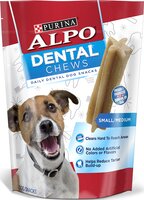
Alpo
Dental Chews
Small/Medium
Alpo
Dental Chews Small/Medium
First Five Ingredients
ricewater sufficient for processing
glycerin
gelatin
chicken by-product meal
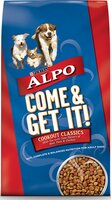
Alpo
Come & Get It
Cookout Classics
Alpo
Come & Get It Cookout Classics
First Five Ingredients
ground yellow corncorn germ meal
beef and bone meal
soybean meal
beef fat
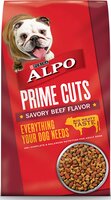
Alpo
Prime Cuts
Savory Beef Flavor
Alpo
Prime Cuts Savory Beef Flavor
First Five Ingredients
ground yellow cornbeef and bone meal
soybean meal
beef fat
animal digest
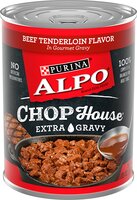
Alpo
Chop House
Beef Tenderloin Flavor In Gourmet Gravy
Alpo
Chop House Beef Tenderloin Flavor In Gourmet Gravy
First Five Ingredients
water sufficient for processingpoultry
liver
wheat gluten
soybean flour

Alpo
Chop House
Rotisserie Chicken Flavor In Gourmet Gravy
Alpo
Chop House Rotisserie Chicken Flavor In Gourmet Gravy
First Five Ingredients
water sufficient for processingchicken
liver
wheat gluten
soybean flour
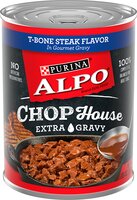
Alpo
Chop House
T-Bone Steak Flavor In Gourmet Gravy
Alpo
Chop House T-Bone Steak Flavor In Gourmet Gravy
First Five Ingredients
water sufficient for processingpoultry
liver
wheat gluten
soybean flour
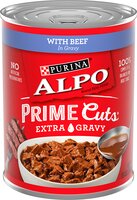
Alpo
Prime Cuts
With Beef In Gravy
Alpo
Prime Cuts With Beef In Gravy
First Five Ingredients
water sufficient for processingmeat by-products
poultry
wheat gluten
soybean flour
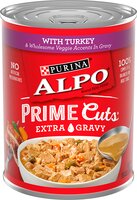
Alpo
Prime Cuts
With Turkey & Wholesome Veggie Accents In Gravy
Alpo
Prime Cuts With Turkey & Wholesome Veggie Accents In Gravy
First Five Ingredients
water sufficient for processingmeat by-products
chicken
turkey
wheat gluten
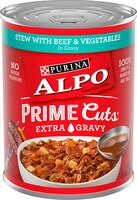
Alpo
Prime Cuts
Stew With Beef & Vegetables In Gravy
Alpo
Prime Cuts Stew With Beef & Vegetables In Gravy
First Five Ingredients
water sufficient for processingmeat by-products
chicken
wheat gluten
beef
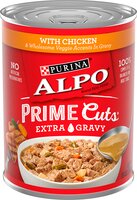
Alpo
Prime Cuts
With Chicken & Wholesome Veggie Accents In Gravy
Alpo
Prime Cuts With Chicken & Wholesome Veggie Accents In Gravy
First Five Ingredients
water sufficient for processingchicken
meat by-products
wheat gluten
turkey
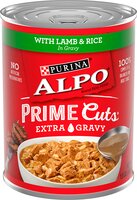
Alpo
Prime Cuts
With Lamb & Rice In Gravy
Alpo
Prime Cuts With Lamb & Rice In Gravy
First Five Ingredients
water sufficient for processingmeat by-products
poultry
wheat gluten
lamb
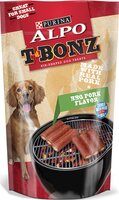
Alpo
Tbonz
BBQ Pork Flavor
Alpo
Tbonz BBQ Pork Flavor
First Five Ingredients
ground wheatwater sufficient for processing
wheat flour
corn gluten meal
glycerin
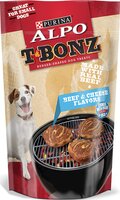
Alpo
Tbonz
Beef & Cheese Flavors
Alpo
Tbonz Beef & Cheese Flavors
First Five Ingredients
ground wheatcorn gluten meal
water sufficient for processing
wheat flour
glycerin
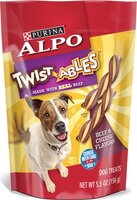
Alpo
Twist-ables
Beef & Cheese Flavors
Alpo
Twist-ables Beef & Cheese Flavors
First Five Ingredients
ground wheatcorn starch
corn gluten meal
water sufficient for processing
wheat flour
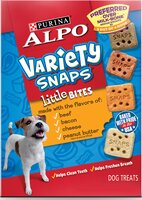
Alpo
Variety Snaps
Little Bites Made With Beef, Bacon, Cheese, and Peanut Butter Flavors
Alpo
Variety Snaps Little Bites Made With Beef, Bacon, Cheese, and Peanut Butter Flavors
First Five Ingredients
wheat flourbeef tallow
wheat gluten
monocalcium phosphate
dicalcium phosphate
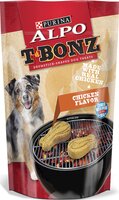
Alpo
Tbonz
Chicken Flavor
Alpo
Tbonz Chicken Flavor
First Five Ingredients
ground wheatcorn gluten meal
water sufficient for processing
wheat flour
glycerin
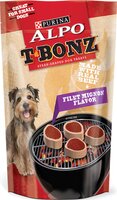
Alpo
Tbonz
Filet Mignon Flavor
Alpo
Tbonz Filet Mignon Flavor
First Five Ingredients
ground wheatwater sufficient for processing
wheat flour
corn gluten meal
glycerin
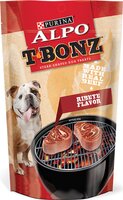
Alpo
Tbonz
Ribeye Flavor
Alpo
Tbonz Ribeye Flavor
First Five Ingredients
ground wheatwater sufficient for processing
corn gluten meal
glycerin
ground yellow corn
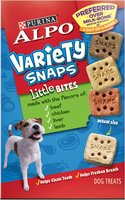
Alpo
Variety Snaps
Little Bites Made With Beef, Chicken, Liver and Lamb Flavors
Alpo
Variety Snaps Little Bites Made With Beef, Chicken, Liver and Lamb Flavors
First Five Ingredients
wheat flourbeef tallow
wheat gluten
lecithin
chicken by-product meal
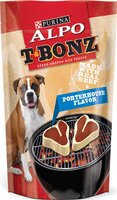
Alpo
Tbonz
Porterhouse Flavor
Alpo
Tbonz Porterhouse Flavor
First Five Ingredients
ground wheatwater sufficient for processing
wheat flour
corn gluten meal
sugar
